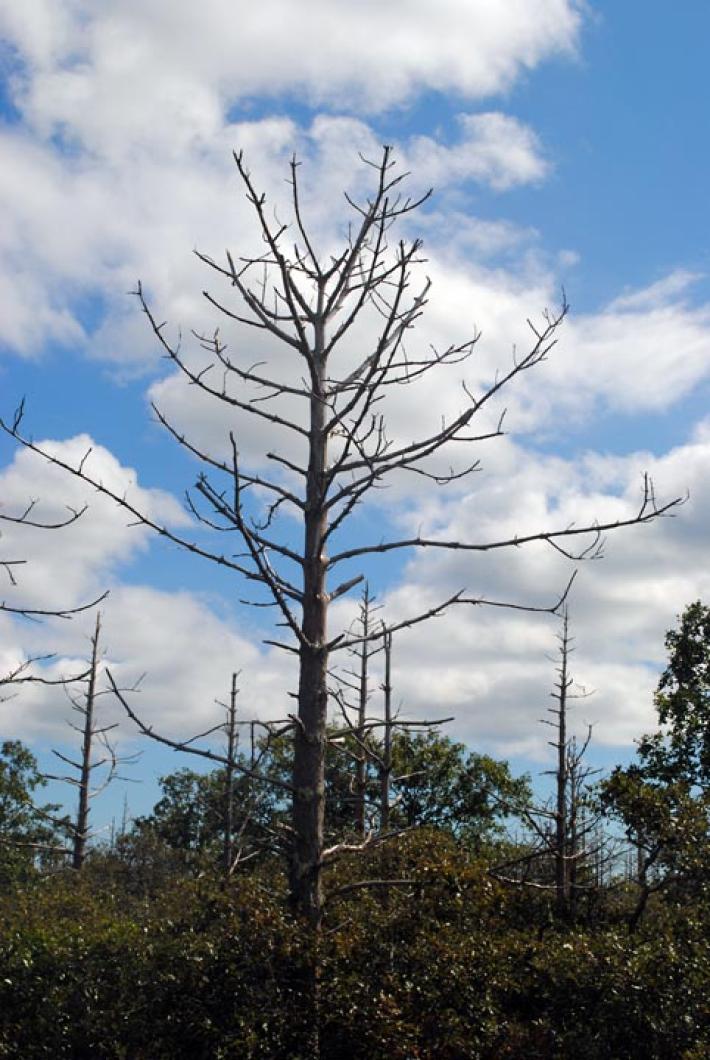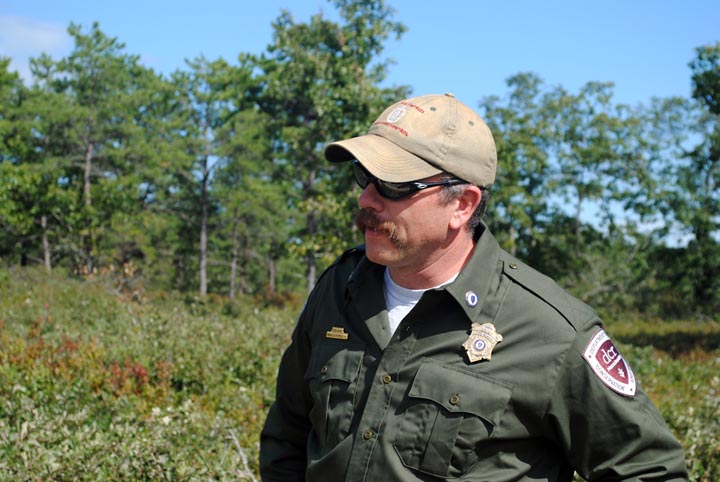The red pine plantations of the Manuel F. Correllus State Forest have been described as recently as 1998 by this paper as a “pine cathedral,” with evenly spaced rows of the northern evergreen towering above a forest floor nearly barren except for a carpet of needles. Now that cathedral has been all but sacked by fungal barbarians known as diplodia pinea which infect the trees from the shoots and rot them to the core. By now over 99 per cent of the forest’s red pines have been hit by the blight, and those woodland naves are being replaced by the traditional dense and rugged vegetation of the Vineyard’s characteristic sandplain ecosystems.
This winter 90 acres of the decaying timber pillars adjacent to the airport will be removed by the Massachusetts Department of Conservation and Recreation in the second phase of a three-year effort that signals the official end of the red pines of Martha’s Vineyard.
Last year the department removed 110 acres worth of defunct pine stands. Given sufficient grant money state officials hope to complete the third phase of the project next year by felling an additional 39 acres.
Starting in 1925, still seven years before the extinction of the last heath hen, the state created the familiar firebreaks that transect the forest and began to plant over 1,700 acres of conifers — almost a third of the forest — in hopes of spawning an Island lumber industry on land that it saw as essentially worthless. Work continued even through the 1960s and, planted in orderly six-by-six-foot rows, the Larch, Norway spruce, Scots pines, white pines and red pines eventually came to dominate many areas of the forest.
Ultimately there wasn’t a market for the Island’s lumber though, and while the industry fizzled the trees remained, many to this day. Already stressed by their unnatural monocultural configurations, the red pines were particularly distressed, planted as they were south of their natural range. Although red pines thrive as far south as north central Massachusetts, on Martha’s Vineyard they became susceptible to disease, such as the pernicious diplodia pinea, and began to die in waves beginning in the 1970s and culminating in 2004 when over 300 acres of the trees died off.
“The lesson is that you have to look at your environment and take into account what’s around you before you try to do something like this,” said state forest supervisor John Varkonda on Thursday. “It didn’t take long for us to see that the red pine was out of its element, so to speak.”
To Mr. Varkonda the plantations represented an outmoded philosophy in forestry fashionable in the early part of the last century, in which forest managers attempted to impose their will on a landscape in order to make it productive. Now, he says, forestry is a more humble practice, with a focus less on industry and more on ecosystem management.
“Back then the idea was this land was vacant land, how can it serve our needs,” he said. “Now we realize that the land is valuable just being there and you don’t need a monetary product for it to be useful to society. The state forest offers not only a variety of recreational activity but it’s also a major protector of the groundwater here on the Island.”
What will come to replace the red pines, and to a large extent already have, are the familiar pitch pines and scrub oak already inured to life on the Island. Although perhaps not as grand or pedestrian-friendly as the red pine stands, the native vegetation supports a variety of rare and endangered moths and butterflies. And, unlike red pine, it promises to stick around.
“Scrub oak is an incredibly resilient plant,” Massachusetts chief fire earden David Celino said during a site visit in September. “When you run it over, it’s like scratching it’s back.”
Ecological concerns aside, the dead timber poses a major fire hazard. Fuel-loading in the state forest is a perennial problem and, planted at densities of up to 1,200 pines per square acre, the remains of the once-proud red pine forest now serve mainly as an ample supply of firewood.
“Because they’re dead and drying, they literally add fuel to the fire,” said Mr. Varkonda.
R.J. Cobb Land Clearing of Bellingham has been hired on a $240,000 contract made possible by a U.S. Forest Service grant to remove and chip the timber (red pine burns quickly and isn’t a particularly efficient firewood). Mr. Varkonda says that he expects the work to begin early next year, when the ground is hard enough for the heavy hydraulic machinery to move in and surgically pluck the trees from the forest floor.
“They are very selective in how they maneuver through the woods,” he said. “They leave all of the standing tree oak essentially. You would be hard pressed to see that they were even in there.”








Comments (2)
Comments
Comment policy »